I made some tiny G clamps to hold the optic fibre rod holders in place - in a non invasive way.
The gap they cover is between 8 and 5mm. Kali plus optic fibre array holder thickness is 6mm.
Felt pads to go underside of Kali.

The gap they cover is between 8 and 5mm. Kali plus optic fibre array holder thickness is 6mm.
Felt pads to go underside of Kali.
Last edited:
The Optic fibre rod was a cheap plastic type (I knew that when I ordered it), it means is easy to cut and doesn't shatter down its length like glass would if you cut it with sidecutters..
Easy to then smooth with fine bench grinder wheel and then onto 400 / 800 / 1200 / 1500 grit wet and dry.
The latter is quite smooth enough to transmit light well.
In fact even just snipped off transmits pretty well!
3mm stuff is very stiff so I heated it with a paint stripper heat gun until pliant and bent it where I wanted.
Not the prettiest I've ever done but it works fine.
The clamps worked like a dream.
The fibre push fitting into both 3mm holes in Najda and the ebony block I made.
With 3mm diameter fibre it's not that critical where the fibre is over the LEDs. Big enough hit area, so very easy to align the array block and clamp gently.
1m only did 5 lights.
Offered another metre!
Quite bright enough to see from listening seat in daylight.
Can someone explain the lights.

Pause and idle sits with 48K and 48K family / Empty on.
Playing my Flac files I get 96K
and lock.. all good. I need to upload some more high res files 😉
Lid can go on soon.
Easy to then smooth with fine bench grinder wheel and then onto 400 / 800 / 1200 / 1500 grit wet and dry.
The latter is quite smooth enough to transmit light well.
In fact even just snipped off transmits pretty well!
3mm stuff is very stiff so I heated it with a paint stripper heat gun until pliant and bent it where I wanted.
Not the prettiest I've ever done but it works fine.
The clamps worked like a dream.
The fibre push fitting into both 3mm holes in Najda and the ebony block I made.
With 3mm diameter fibre it's not that critical where the fibre is over the LEDs. Big enough hit area, so very easy to align the array block and clamp gently.
1m only did 5 lights.
Offered another metre!
Quite bright enough to see from listening seat in daylight.
Can someone explain the lights.
Pause and idle sits with 48K and 48K family / Empty on.
Playing my Flac files I get 96K
and lock.. all good. I need to upload some more high res files 😉
Lid can go on soon.
Last edited:
I noticed immediately no light when playing 44.1!
I had never really looked at the Kali lights before, so it is possible my 44.1K light never worked.
Also the lights go colour wise.
44.1K ?
48K Green
88.2K Blue
96K Green
176.4K ? (I don't have any Flacs at this rate)
192K Green
Higher than 192K files of which I have a few just light up the 192 LED. WaveIO used to give a combination of 176+192 for them.
That was elegant I thought.
So if I can't get the 44.1K light to work at all, I'll just use the 44.1K Family LED that is blue and always comes on when they are played.
I had never really looked at the Kali lights before, so it is possible my 44.1K light never worked.
Also the lights go colour wise.
44.1K ?
48K Green
88.2K Blue
96K Green
176.4K ? (I don't have any Flacs at this rate)
192K Green
Higher than 192K files of which I have a few just light up the 192 LED. WaveIO used to give a combination of 176+192 for them.
That was elegant I thought.
So if I can't get the 44.1K light to work at all, I'll just use the 44.1K Family LED that is blue and always comes on when they are played.
The extra 3mm optic fibre I needed to finish the job came.
I've got the 44.1K slot fed from Kali's 44.1K Family Led.
I also have another one showing Lock (blue) and empty (red) as a combined light slot.
Those two LEDs are so close together on Kali that the 3mm optic fibre covers both! So it works as a dual colour led! Quite a neat feature, if not originally reckoned for.
I made a second small block to hold the two optic fibres for this.
This pic was taken with the main ceiling spot lights on.
Showing standby, a combination of 48K and Empty Leds

At each track change on Spotify it briefly goes to the standby light combo then 44.1K and Lock Leds as the next track is cued up.
I can live with this it's perfect!
Thankfully there is no click, crack or pop between tracks.
Najda does a beautiful job of blocking all that out.
A friend who also uses RPi / Kali into a Dac with I2S has quite a loud pop each time..
I needed to rename the last two lights on the right. Black permanent marker at the ready 😉
Even got the lid on Najda!
I might put a RPi SD card read Led indicator on as well. But not on the front. Perhaps to the side out of normal view. It's just to check there's not micro SD writing during ROi power downs.
I've got the 44.1K slot fed from Kali's 44.1K Family Led.
I also have another one showing Lock (blue) and empty (red) as a combined light slot.
Those two LEDs are so close together on Kali that the 3mm optic fibre covers both! So it works as a dual colour led! Quite a neat feature, if not originally reckoned for.
I made a second small block to hold the two optic fibres for this.
This pic was taken with the main ceiling spot lights on.
Showing standby, a combination of 48K and Empty Leds
At each track change on Spotify it briefly goes to the standby light combo then 44.1K and Lock Leds as the next track is cued up.
I can live with this it's perfect!
Thankfully there is no click, crack or pop between tracks.
Najda does a beautiful job of blocking all that out.
A friend who also uses RPi / Kali into a Dac with I2S has quite a loud pop each time..
I needed to rename the last two lights on the right. Black permanent marker at the ready 😉
Even got the lid on Najda!
I might put a RPi SD card read Led indicator on as well. But not on the front. Perhaps to the side out of normal view. It's just to check there's not micro SD writing during ROi power downs.
Last edited:
Not been doing much apart from listening a lot!
I finally bit the bullet, some 5 years after talking about it! House move and total garden landscape from scratch, got in the way.
I made the throat adapters to enable the use of Eminence Kappa 12A drivers, in place of the JBL 2220A 15" drivers.
Modelling the throat / new horn that would be, gave;
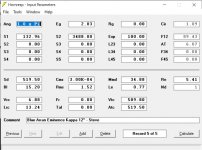
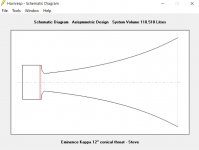
I made the throat adapters out of 11 rings of 21mm birch plywood, bonded and screwed together.
Fit was very good to the 20cm big throat of the short horn (as was).
Hornresp (thanks David), gave the cutting angles and it all fitted nicely - okay a little two pack filler and sanding needed [emoji846]
Initial listening was positive. More texture and pressure on some of the upper bass. Lost a bit lower down though!
I dusted off the measuring equipment and saw the problem!
Bass rolling off too soon.
That'll be the volume of the back box then! I was prepared for this.
The total volume of the back box is 31lts.
Driver takes up some.
Hornresp said 14 odd lts for the JBLs.
Only 7 for the Kappa 12As.
I'd made some hard non-porous foam inserts for this you'll recall.
So, I set about adding to them to account for the smaller 12" driver basket and half the volume.
Soon done!
Measurement showed an improvement down to meet the tapped horns nicely.
Listening again it's all there!
The correct compression ratio driver to mouth gives more horniness! It's around 4:1 now.
For some reason the Hornresp prescribed ratio never worked with the JBLs!
There is now a stepped throat of 8" down to the 5" one now of course (21mm long). That actually models better for the 12" drivers than without. It's bevelled in Hornresp.
I've yet to try that mod.
So, finally moved from 15 to 12" on mid bass.
Rewind! Are you there? [emoji3]
I put the JBLs up for sale, and they sold quickly. They are going to a good home[emoji106]
I finally bit the bullet, some 5 years after talking about it! House move and total garden landscape from scratch, got in the way.
I made the throat adapters to enable the use of Eminence Kappa 12A drivers, in place of the JBL 2220A 15" drivers.
Modelling the throat / new horn that would be, gave;


I made the throat adapters out of 11 rings of 21mm birch plywood, bonded and screwed together.
Fit was very good to the 20cm big throat of the short horn (as was).
Hornresp (thanks David), gave the cutting angles and it all fitted nicely - okay a little two pack filler and sanding needed [emoji846]
Initial listening was positive. More texture and pressure on some of the upper bass. Lost a bit lower down though!
I dusted off the measuring equipment and saw the problem!
Bass rolling off too soon.
That'll be the volume of the back box then! I was prepared for this.
The total volume of the back box is 31lts.
Driver takes up some.
Hornresp said 14 odd lts for the JBLs.
Only 7 for the Kappa 12As.
I'd made some hard non-porous foam inserts for this you'll recall.
So, I set about adding to them to account for the smaller 12" driver basket and half the volume.
Soon done!
Measurement showed an improvement down to meet the tapped horns nicely.
Listening again it's all there!
The correct compression ratio driver to mouth gives more horniness! It's around 4:1 now.
For some reason the Hornresp prescribed ratio never worked with the JBLs!
There is now a stepped throat of 8" down to the 5" one now of course (21mm long). That actually models better for the 12" drivers than without. It's bevelled in Hornresp.
I've yet to try that mod.
So, finally moved from 15 to 12" on mid bass.
Rewind! Are you there? [emoji3]
I put the JBLs up for sale, and they sold quickly. They are going to a good home[emoji106]
Last edited:
This afternoon's mucking about has been to make stands so the upper mids (Vitavox S2's on 500Hz horns) and the tweeters (Raal Lazy ribbons) could stay in the same place, with lots of air around them, whilst the mid bass horns could be pushed back onto the back wall.
This not only takes care of the mid bass horns not protruding into the room as much - they are quite a bit longer now, but also loads them better.
I re-time aligned the while lot in Najda.
The tapped and mid horns have not moved and were still spot on when checked.
Measuring the frequent Vs amplitude curve, I got a bit better bass extension and a slightly more even curve!
Listening tests revealed better mid bass directivity / stereo imaging.
The latter was a nice unexpected bonus!
Onwards and upwards.
It's interesting moving the horns about, then putting them back physically as close as possible - can tell the sound gets slightly ragged.
Time aligning in DSP has everything snapped back in focus again.
Just sounds right.
This not only takes care of the mid bass horns not protruding into the room as much - they are quite a bit longer now, but also loads them better.
I re-time aligned the while lot in Najda.
The tapped and mid horns have not moved and were still spot on when checked.
Measuring the frequent Vs amplitude curve, I got a bit better bass extension and a slightly more even curve!
Listening tests revealed better mid bass directivity / stereo imaging.
The latter was a nice unexpected bonus!
Onwards and upwards.
It's interesting moving the horns about, then putting them back physically as close as possible - can tell the sound gets slightly ragged.
Time aligning in DSP has everything snapped back in focus again.
Just sounds right.
Last edited:
I'm back on the 400Hz upper mid horns (the smallest of the 3 in the shot below).
It's probably a change is as good as a rest type of thing![emoji3]

One of the 550Hz horns can be seen on the floor to the left.
I also been messing about with the X/O between the tapped horn subs and relatively new extended mid bass Kappa 12 horns.
Previous playing around had them at 8th order low pass on the tapped horns and 4th order upper pass on the mid bass.
I changed this to 6th order on the tapped horns.
Still on Linkwitz Riley.
This I guess allows more prominence to the upper range of the tapped horns to be heard a little more, effectively utilising the rear cone movement more as it fills in usual front loaded bass horn hole.
Or perhaps that frequency is a little lower down?
I also loaded Najda in the same but with Bessel.
After listening I could not in general hack the Bessel filter. It's just too much.
Sounds great on some tracks but L-R is just a so much more rounded performer, versatile and 'right' sounding across all music types.
Note also the green light on Najda.
That indicates optical input from the pimped Chromecast Audio.
Very pleased with the changes
It's probably a change is as good as a rest type of thing![emoji3]
One of the 550Hz horns can be seen on the floor to the left.
I also been messing about with the X/O between the tapped horn subs and relatively new extended mid bass Kappa 12 horns.
Previous playing around had them at 8th order low pass on the tapped horns and 4th order upper pass on the mid bass.
I changed this to 6th order on the tapped horns.
Still on Linkwitz Riley.
This I guess allows more prominence to the upper range of the tapped horns to be heard a little more, effectively utilising the rear cone movement more as it fills in usual front loaded bass horn hole.
Or perhaps that frequency is a little lower down?
I also loaded Najda in the same but with Bessel.
After listening I could not in general hack the Bessel filter. It's just too much.
Sounds great on some tracks but L-R is just a so much more rounded performer, versatile and 'right' sounding across all music types.
Note also the green light on Najda.
That indicates optical input from the pimped Chromecast Audio.
Very pleased with the changes
Last edited:
After auditioning a Mutec reclocker SPdif, I wondered if there was more mileage in RPI/Kali.
Read up some on I2S and upgraded my RPI/Kali - > Najda connections!
All crimped now and not soldered.
Added an extra earth, Audio data always had one, frame synch had one, clock now has one.
Made sure the earth's are all tight to the data / synch & clock. They were not before.
Same short as possible length.
Used pure silver hook up wire (overkill I know, but that extra 7% conductivity[emoji23]).
The difference is quite noticeable.
It's like adding another or even better re-clocker!
Sticking with RPI/Kali now!
Read up some on I2S and upgraded my RPI/Kali - > Najda connections!
All crimped now and not soldered.
Added an extra earth, Audio data always had one, frame synch had one, clock now has one.
Made sure the earth's are all tight to the data / synch & clock. They were not before.
Same short as possible length.
Used pure silver hook up wire (overkill I know, but that extra 7% conductivity[emoji23]).
The difference is quite noticeable.
It's like adding another or even better re-clocker!
Sticking with RPI/Kali now!
I've been Le Cléac'h horn profile curious for a quite a while.
The only place I could fit them in would be the Upper mid, Vitavox S2 channel.
I decided to make a pair of 550Hz cut off freq could.
Using Hornresp @davidbean
First I chose a T that gave the same throat angle as the driver exhibits.

I made a thin plywood template with feathered edges.
Next the problem of turning something over 12" in diameter.
My lathe is only 9" swing!
I re-purposed my end sander.
Nice fast rpm, strapped it down.
The centre bolt securing the disc on the sander doubled nicely as a fixing bolt. I made these shorter as material was removed.
I glued up some Douglas fir softwood and made discs. As true as possible.
Even so I suffered some imbalance due to mismatches in the mass of the different pieces of wood on one of the horns. I balanced these using car wheel balancing weights screwed on the back.

I found quite crude tool rests worked. Fast rpm and the right angle of sharp chisels.
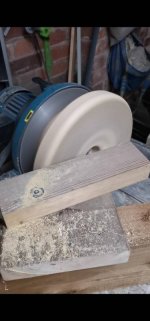
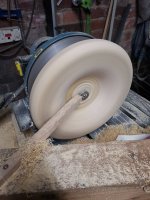
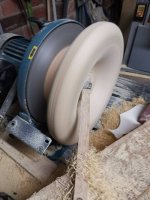
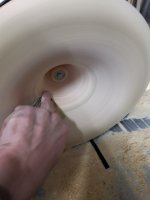
The smaller throats I turned on my lathe.

Laminated together and a bit of smoothing by hand
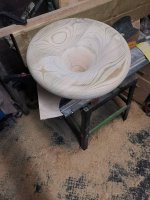
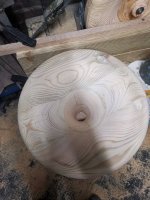
More to follow
The only place I could fit them in would be the Upper mid, Vitavox S2 channel.
I decided to make a pair of 550Hz cut off freq could.
Using Hornresp @davidbean
First I chose a T that gave the same throat angle as the driver exhibits.
I made a thin plywood template with feathered edges.
Next the problem of turning something over 12" in diameter.
My lathe is only 9" swing!
I re-purposed my end sander.
Nice fast rpm, strapped it down.
The centre bolt securing the disc on the sander doubled nicely as a fixing bolt. I made these shorter as material was removed.
I glued up some Douglas fir softwood and made discs. As true as possible.
Even so I suffered some imbalance due to mismatches in the mass of the different pieces of wood on one of the horns. I balanced these using car wheel balancing weights screwed on the back.

I found quite crude tool rests worked. Fast rpm and the right angle of sharp chisels.




The smaller throats I turned on my lathe.

Laminated together and a bit of smoothing by hand


More to follow
Last edited:
Yes, it had to be done.I had a feeling you would one day 😉
More progress;
Made a pair
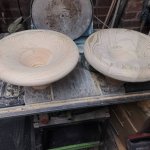
Used adapter rings I'd made up for the 400Hz tractrix horns some 6 odd years ago! Had the feeling I would not be going back to them..
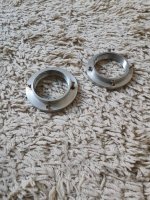
Then installed
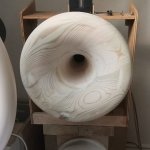
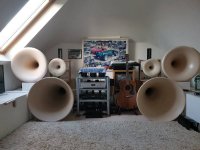
I needed to raise the Raal Lazy ribbons a little bit higher. Fortunately I had future proofed my rather rustic tweeter and upper mid horn rack.
Quick twiddle of the wing nuts and slide up.
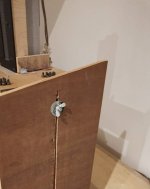

Look quite cool!
View attachment 930563
Next up, what difference have they made.
Last edited:
I decided to fine sand treat the Le Cléac'h horns.
This gives fine sand texture that is sealed in by lacquer sprayed on.
This is the same as I did for the Tractrix horns I previously used for the upper mids - I liked it.
I've also been experimenting using absorbing materials on the backs of the surrounding horns.
This has proved beneficial for the Le C horns - I'd not previously found it necessary!
Perhaps that's down to the more pointy nature of Tractrix compared to Le C, or that the larger Le C diameter means they are nearer?
I had previously tried foam but prefer needled wool felt.
What are your views on absorption materials and use like this?
This gives fine sand texture that is sealed in by lacquer sprayed on.
This is the same as I did for the Tractrix horns I previously used for the upper mids - I liked it.
I've also been experimenting using absorbing materials on the backs of the surrounding horns.
This has proved beneficial for the Le C horns - I'd not previously found it necessary!
Perhaps that's down to the more pointy nature of Tractrix compared to Le C, or that the larger Le C diameter means they are nearer?
I had previously tried foam but prefer needled wool felt.
What are your views on absorption materials and use like this?
First guesses would be that the tractrix' more distinct edge diffraction might have been trimming directivity by coincidence, especially at certain lower frequencies. LeCléac'h would gently be teasing it out further.
If this is true then the interruption has at least been delayed further than the horn edge, so in the bigger picture it may be worthwhile proceeding and trying to absorb the problem areas.

If this is true then the interruption has at least been delayed further than the horn edge, so in the bigger picture it may be worthwhile proceeding and trying to absorb the problem areas.

Yes.First guesses would be that the tractrix' more distinct edge diffraction might have been trimming directivity by coincidence, especially at certain lower frequencies. LeCléac'h would gently be teasing it out further.
If this is true then the interruption has at least been delayed further than the horn edge, so in the bigger picture it may be worthwhile proceeding and trying to absorb the problem areas.

When I put the needled felt out, first on surfaces that could reflect around the Le Clèac'h horns and then the tweeters to Le C horns too, higher frequencies became calmer.
Not any less detailed or engaging.
In fact I heard some new detail and reverberations not previously prominent enough to notice.
Also interestingly, the volume of those channels increased a bit.
My take is that soundwaves previously reflecting are absorbed, or part absorbed. Net gain is that more direct sound waves get to me. Less cancellations.
The wide nature of Le Clèac'h and roll around mouth means more propagation right around the back of the horn. It gives that unique Le Clèac'h sound, but you don't want too much perhaps.
I'm going to experiment more.
If you go to Bjorn Kolbrek's site - BEM Simulations
and run down the side of the page 'till you get to -
014 AH425 360 deg mouth sound field
you will see the radiation pattern for different frequencies on a 425Hz horn, and you can scale them to suit yours.
and run down the side of the page 'till you get to -
014 AH425 360 deg mouth sound field
you will see the radiation pattern for different frequencies on a 425Hz horn, and you can scale them to suit yours.
Attachments
Today's refinement was to 'sand' down the sand finish in the throats of the Le Cléac'h.
The immediate area mating to the compression drivers are now smooth and then transition to sand texture that covers the entire rest of the horns.
This was always the plan, had to be done in stages, and interesting listening to the change.
Listening now - this is the ultimate 'rightness' I've heard from my S2 drivers (so far)!
The immediate area mating to the compression drivers are now smooth and then transition to sand texture that covers the entire rest of the horns.
This was always the plan, had to be done in stages, and interesting listening to the change.
Listening now - this is the ultimate 'rightness' I've heard from my S2 drivers (so far)!
Having read lots of JMLC input on this site, I toed the 550Hz / Vitavox S2 combos in. To cross 60cm in front of me.
I never liked toe in with my Tractrix set up.
With the Le Cléac'h horns it was very different. Toe in was an instant hit!
I removed the felt acoustic damping too!
Next up was to examine the crossover points and time align afresh.
I have pretty much exclusively used a 3uF cap on the S2 upper mid horns.
This takes care of the bulge in amplitude the S2 has and magically gives a smooth crossover point of around 1200Hz.
That is how I liked the Tractrix.
I decided to try Najda as the X/0 and tried 3000Hz, 2700, 2500 and 2300 as well.
I also found I liked 2nd order and LR.
With suitable adjusting of the mid horns crossover points, I found I liked 2300Hz on the S2s. The JBL mids are crossed lower than this. Nadja is taking care of the S2 hump the same.
Here's a measurement done at the listening position.
As can be seen the S2s are ramping down higher than 1200Hz.
No matter, this sounds better than the 3uF cap by some margin.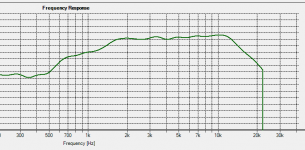
Further listening proved I like the XO point at 2300Hz!
I never liked toe in with my Tractrix set up.
With the Le Cléac'h horns it was very different. Toe in was an instant hit!
I removed the felt acoustic damping too!
Next up was to examine the crossover points and time align afresh.
I have pretty much exclusively used a 3uF cap on the S2 upper mid horns.
This takes care of the bulge in amplitude the S2 has and magically gives a smooth crossover point of around 1200Hz.
That is how I liked the Tractrix.
I decided to try Najda as the X/0 and tried 3000Hz, 2700, 2500 and 2300 as well.
I also found I liked 2nd order and LR.
With suitable adjusting of the mid horns crossover points, I found I liked 2300Hz on the S2s. The JBL mids are crossed lower than this. Nadja is taking care of the S2 hump the same.
Here's a measurement done at the listening position.
As can be seen the S2s are ramping down higher than 1200Hz.
No matter, this sounds better than the 3uF cap by some margin.

Further listening proved I like the XO point at 2300Hz!
Last edited:
I decided to re-examine my tapped horn bass / sub bass implementation a little.
In my previous room (2010-2015), I had some modes but nothing too serious.
I found the tapped horns sounded and measured best in the far corners firing into the room facing each other.
This was also found to be the case at the 2012 Scalford (Hi-fi Wigwam bring your own kit) show.
There the room was er, large!
Easily seating 25 people and 20 or more standing around at the back and sides. Filled that room with sound no problem.
In both these rooms there was a pleasing deep bass expression on certain tracks. I got used to this. I listened to some other sub bass horn implementations, a Lab-12 horn system stick in my mind as having a similar deep bass response.
So on to this loft room (2015- ).
Room mode calculators show exactly what my measurements show.
Room mode at 29Hz.
They don't show the suck out at 54Hz though and a bit of a peak again at 79Hz (mostly RH only).
EQ'ing could only get me so far.
Experimenting pouring power into the 54Hz suck out had little tangible effect at the listening sofa.
Boomy as hell at certain points in the room.
Previously on setting up the system I'd tried various arrangements of the tapped horns, and found them to work best in the corners firing upwards.
However the work back then was not exhaustive!
Most of my measuring was done as left and right hand separately - big mistake!
Cutting the massive 29Hz boom and e lesser 79Hz one is easy!
Getting to a flat curve on left and then right didn't sound so good when listening to my favourite bass test tracks.
Beck then I arrived at a compromise.
FFW to April 2021, I now tried swapping one tapped horn RH around. No better, worse in fact!
I then tried it with the LH firing upwards and the RH firing across the room.
This sounded better.
I then EQ'd the RH cutting 29 and 74Hz to close to the 54Hz level.
I left the RH with a big cut at 29Hz and not massive boost at 54Hz. No cut at 74Hz needed on the LH side.
This time measuring both tapped horns at the same time gave a very nice flat response.
Listening showed that dynamics were good and yes that nice deep bass response I had missed was indeed back!
I can only surmise that EQ'ing both to around flat was somehow facilitating a cancellation in that particular frequency I was missing / wanted to hear more of.
Anything below 60Hz is pretty much nondirectional. So getting them working as a sub 60Hz pair was very good for me.
I cross the tapped horns 6th order at 90Hz to a pair of Exponential 12" front loaded horns you'll recall.
Anyway, the deep bass is now excellent again. Only took 5 years[emoji23]
In my previous room (2010-2015), I had some modes but nothing too serious.
I found the tapped horns sounded and measured best in the far corners firing into the room facing each other.
This was also found to be the case at the 2012 Scalford (Hi-fi Wigwam bring your own kit) show.
There the room was er, large!
Easily seating 25 people and 20 or more standing around at the back and sides. Filled that room with sound no problem.
In both these rooms there was a pleasing deep bass expression on certain tracks. I got used to this. I listened to some other sub bass horn implementations, a Lab-12 horn system stick in my mind as having a similar deep bass response.
So on to this loft room (2015- ).
Room mode calculators show exactly what my measurements show.
Room mode at 29Hz.
They don't show the suck out at 54Hz though and a bit of a peak again at 79Hz (mostly RH only).
EQ'ing could only get me so far.
Experimenting pouring power into the 54Hz suck out had little tangible effect at the listening sofa.
Boomy as hell at certain points in the room.
Previously on setting up the system I'd tried various arrangements of the tapped horns, and found them to work best in the corners firing upwards.
However the work back then was not exhaustive!
Most of my measuring was done as left and right hand separately - big mistake!
Cutting the massive 29Hz boom and e lesser 79Hz one is easy!
Getting to a flat curve on left and then right didn't sound so good when listening to my favourite bass test tracks.
Beck then I arrived at a compromise.
FFW to April 2021, I now tried swapping one tapped horn RH around. No better, worse in fact!
I then tried it with the LH firing upwards and the RH firing across the room.
This sounded better.
I then EQ'd the RH cutting 29 and 74Hz to close to the 54Hz level.
I left the RH with a big cut at 29Hz and not massive boost at 54Hz. No cut at 74Hz needed on the LH side.
This time measuring both tapped horns at the same time gave a very nice flat response.
Listening showed that dynamics were good and yes that nice deep bass response I had missed was indeed back!
I can only surmise that EQ'ing both to around flat was somehow facilitating a cancellation in that particular frequency I was missing / wanted to hear more of.
Anything below 60Hz is pretty much nondirectional. So getting them working as a sub 60Hz pair was very good for me.
I cross the tapped horns 6th order at 90Hz to a pair of Exponential 12" front loaded horns you'll recall.
Anyway, the deep bass is now excellent again. Only took 5 years[emoji23]
- Home
- Loudspeakers
- Multi-Way
- 5 way horn speaker system project - tapped, bass, mids and tweeter passive active

